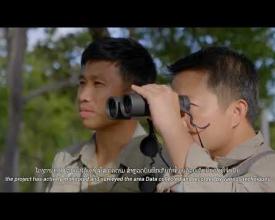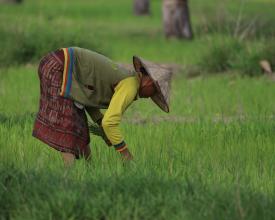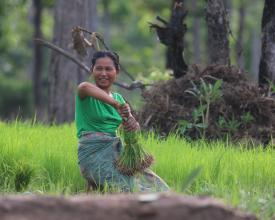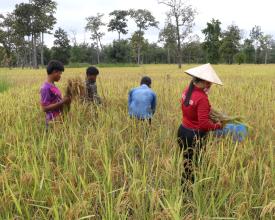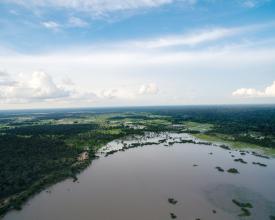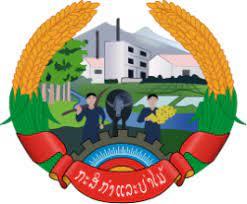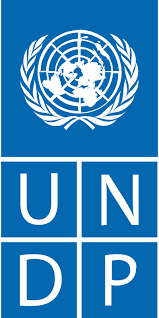
Sustainable Forest and Land Management in the Dry Dipterocarp Forest Ecosystems of Southern Lao PDR
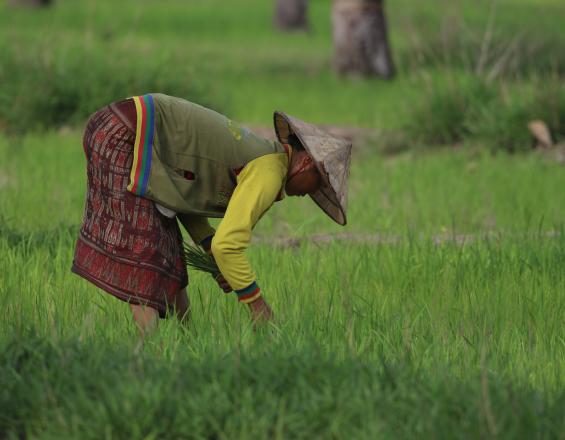
The Sustainable Forest and Land Management in the Dry Dipterocarp Forest Ecosystems of Southern Lao Project, “SAFE Ecosystem Project” works in southern part of the country. The objective is to facilitate a transformative shift from unsustainable to integrated sustainable land and forest management in the dry dipterocarp forest landscape in order to secure critical wildlife habitats, conserve biodiversity, maintain ecosystems and support livelihoods' development.
It supports local communities to participate in wildlife protection, strengthening of alternative sources of likelihoods besides supporting upgrading of protected areas as part of the effort to that protect natural habitat, reverse environmental degradation, as well as supporting local livelihoods, providing alternative income -generating opportunities for communities and reinforcing their support for biodiversity conservation. A participatory approach was complemented by relevant government departments.
Context
Challenges addressed
- Limited sources of income generating activities leading to overdependence on natural resources
- Communities impotent to prevent habitat loss and ecosystem degradation resulting in impoverished subsistence livelihoods
- Overharvesting and forest crimes leading to decline in wildlife population
- Limited capacity and resources by relevant agencies to conserve biodiversity and wildlife.
Building blocks
Conservation agreements
Development of alternative livelihoods generating activities
Public awareness on environmental and biodiversity conservation
Location
Process
Summary of the process
Key success factors - and the project activities that are structured to support these solution building blocks - must be coherent and coordinated. Conservation agreements will fail if communities are unaware of the initiative or the benefits it will provide. Similarly, conservation agreements cannot succeed in the absence of alternative livelihoods. When the project building blocks work together across the project landscape, it ensures that the project's goals and objectives will be sustainable over the long-term, securing both community and ecosystem well-being.
Building Blocks
Community Conservation Agreements
Community Conservation Agreements are a negotiated exchange of benefits in return for changes in resource use, depending on verified performance. Once a village development committee and government authorities formalize a Conservation Agreement, it is used as the framework for all development activities within the project, and integrated with land-use planning. Benefits are channeled through village development funds, and include support for village development committees in managing the funds by building village level capacity, thereby ensuring that appropriate access and benefit sharing provisions are included in all CAs.
Enabling factors
- Community engagement
- Village institution development
- Livelihood / income support
- Wages (training & equipment) for conservation jobs (patrolling, monitoring, reforestation)
- Investment in social services and infrastructure
- Investment in livelihood activities
Lesson learned
- Project teams need to monitor and assess the compliance and performance of the villages with the CAs
- CAs need to be renegotiated when necessary to ensure long-term suitability and community engagement
- Incentives for high performance (and disincentives for low performance) should be built in.
Resources
Development of Alternative Livelihoods
The overall project objective is "to facilitate a transformative shift towards sustainable land and forest management in the forested landscape of Savannakhet Province in order to secure the critical wildlife habitats, conserve biodiversity and maintain a continuous flow of multiple services including quality water provision and flood prevention." This transformative shift to sustainability is predicated on the provision of adequate alternatives to unsustainable resource use. Previous unsustainable usages of the project's forested landscapes (e.g. logging, poaching) will not cease unless replacement livelihood activities provide an economic benefit and improve income generation for participating villagers.
Enabling factors
- Integration with other project activities (e.g. if improved animal husbandry methods could keep cattle and buffalo near villager’s homes, then the manure from these animals could be collected and processed to make organic fertilizer which could be used for home gardens and rice production)
- Recruitment of support specialists
- Planning and preparation
- Needs assessments
- SWOT analyses
- Monitoring and Evaluation
- Conservation contracts
Lesson learned
- The quality of livestock extension activities is vital
- Livelihood activities need to be integrated with all project activities, rather than siloed
- Targets and indicators should be adhered to
- Activities should be designed to identify how they address the overall goals and objectives of the project
Public awareness on environmental and biodiversity conservation
Community buy-in and participation are key building blocks for project success and sustainability. These depend in large measure on community awareness of the project itself, as well as its intended benefits, beneficiaries, and long-term viability. Raising awareness around new protected areas, revised laws/regulations, community conservation agreements, etc. is also a key element of effective enforcement and interdiction, and assuring community adherence to conservation plans.
Enabling factors
- Creation and dissemination of messages that are comprehensible to locals, using appropriate vernacular (including media such as radio that do not require universal literacy)
- Increased awareness of the benefits of environmental conservation increases community feelings of ownership of planted seedlings
- Local community authorities play a vital role in involving community members and consensually ensuring adherence to agreed regulations
Lesson learned
- Deforestation and loss of biodiversity take place in situations where there is a lack of awareness of the importance of forests for biodiversity conservation and sustainable livelihoods among local communities
- Limited alternative livelihoods sources drive unsustainable utilization of forest resources and other factors including weak enforcement capacities to limit wildlife and forest crimes
- Communities are willing to change when provided with viable options as was evident from the adoption of SRI rice production resulting to reduced pressure to encroach on forest land for agricultural production
- For initiatives to be effective, viable and sustainable, economic alternatives to using forest resources need to be provided, to compensate for losses incurred due to restrictions imposed on the use of the forest resources
Impacts
The project`s community participatory approach, capacity building and implementation of conservation contract besides ecotourism development in the site for conservation of wild life particularly the eld`s deer (Rucervus eldii) delivered significant results in terms of community behavioral change and doubling the population.
Communities were empowered by training and provision of basic equipment enabled, participation in monitoring, reporting and enforcement of regulations. Furthermore, implementation of conservation agreements improved their well-being and enhanced their responsibility to conserve natural resources by reducing their dependance on forest products. The governance at the village level was improved with infrastructure support and capacity building on project management. Livelihoods' opportunities were availed equally including for youth and women as part of the efforts to ensure sustainable management of natural resources.
Working with relevant government agencies has resulted in development of protected area management plans and business plans besides strengthening of community conservation units prevented hunting of endangered species resulting to population increase from 75-80 in 2016 to over 170 individuals in 2021.
Beneficiaries
Local communities in Savannakhet Province
Sustainable Development Goals
Story

The SAFE Ecosystem project commenced in 2016, at the time overdependence on natural resources and conversion of critical habitat had threatened the ecosystem resulting to habitat loss and degradation impacting negatively on the livelihoods and sustainable utilization of natural resources.
At the project inception, local communities used to hunt the eld`s deer, with limited understanding of their importance and encroachments of the protected area further threatened the ecosystem. Community engagements revealed more about the underlying causes: communities’ perception, reward for participation and the level of awareness about the eld`s deer and the ecosystem in general. They also expressed their willingness to take part in the initiatives to protect the endangered species and conserve the habitat. Dissemination of the revised forest law and regulations was used in creating awareness of the importance and the responsibility of the local communities in conservation and sustainable use of natural resources.
The project supported the building of a conservation team and also utilized the existing community structure “village development committee “in implementing activities as per the conservation agreements. The village development committee received financial support based on the implementation of the various activities as per the agreements. It ensured, that implemented activities were inclusive and documented. Benefits were shared, reinforcing local development and support for forest and wildlife conservation.
As a results of the community participatory approach with government support as well as tailed benefits, communities have not only been empowered to conserve the biodiversity but also appreciated the importance of conserving for development and future generations. Hunting became a thing of the past and the area attracted large number of tourists.

